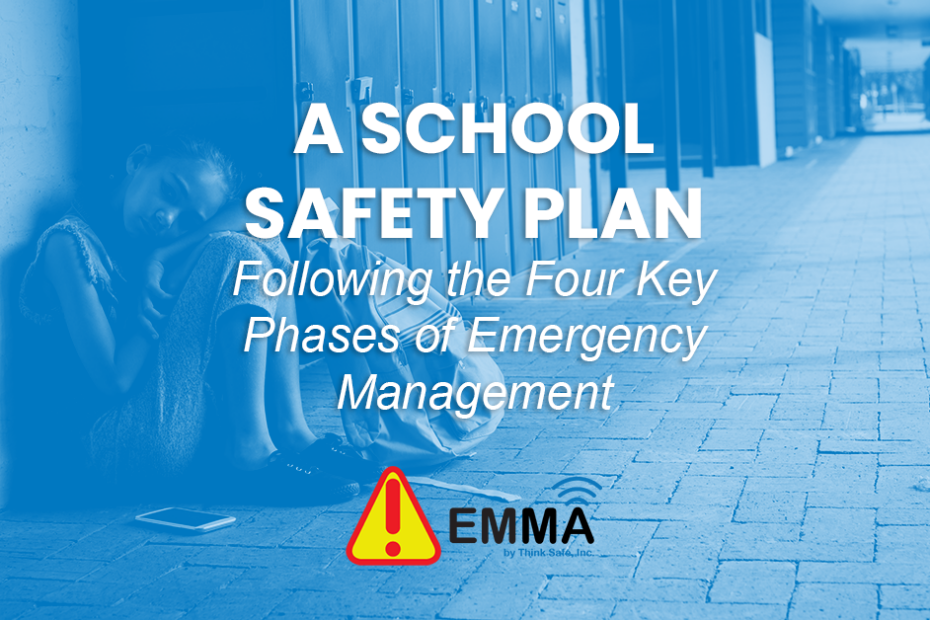School Safety Plan — Prevent, Prepare, Respond and Review
A school safety plan is designed to protect the staff, students and others from physical harm related to risks such as weather-related incidents, gas leaks, fires, bomb threats and active shooter or violent threats on or near the campus and while using school transportation. The four phases of emergency management can ensure an organized, systematic school safety plan: Prevention, Preparation, Response, and Review.
Prevent Future Emergencies and Take Steps to Maximize Their Effects
Prevention focuses on taking steps to protect students before an incident occurs, while also decreasing risks and consequences from a given perceived risk or potential disastrous situation. A school safety plan’s main goal should be to reduce and prevent vulnerability to events that threaten safety (such as bullying, emergency medical-related injuries, severe weather, and loss of life from mass shooting events).
The Partner Alliance for Safer Schools (PASS) publishes “Safety and Security Guidelines” that provides a layered approach for addressing a broad range of threats. This is an excellent resource for the development of a school safety plan. Their guidelines suggest that policies and procedures are the backbone of a comprehensive school safety plan. Effective policies and procedures alone can mitigate risks and there are often no costs associated with implementing them. Take care to also consider how key tools for Anonymous Bullying Reporting (or ‘Anti-Bullying’ policies to include mobile apps and website forms) which can also assist students in helping prevent and thwart violent actions.
EMMA's customizable library makes it easy to securely store documented safety policies and procedures — allowing them to be accessed by designated user groups.
Prevention
- Documented Safety Policies & Procedures
-
- Roles and Responsibilities
- Annual Physical Security Assessments
- Visitor Badging System
- Incident Report Documentation
- Lockdown Drills
- Student/Faculty ID Badges
- Deterrents (Video Surveillance)
- Detection and Alarms
Prepare to Handle Emergencies That May Arise
Preparation
- Training
- Education
- Drills
- Tabletop Exercises
- Full-Scale Exercises
- Incident Command System
- Emergency Supplies and Equipment
Preparedness is a continuous cycle of activities such as staff training, drills, assessment, and remedial actions. Preparedness and readiness go hand in hand. Preparing for emergency situations or potential threats ensures that administration, faculty and staff, and students know what to do in the event of an occurrence. Emergencies are going to happen. Not only practicing and preparing for the emergency is important but also making sure your school has the preparedness supplies and equipment to respond. During a real emergency, every minute matters, so preparation is the key to improving outcomes and even saving lives.
With EMMA, emergency response exercises can be planned and executed to make sure everyone has in-depth training and practice experience with different incident scenarios, equipment and environments.
Respond Safely to Emergencies in Ways That Make Minutes Matter
The minutes between a threat or an emergency event and the time dispatched 911 responders arrive on site are critical to the most successful outcomes. The “response” phase occurs in the immediate aftermath of an incident. Student safety and wellbeing largely depends on the preparedness levels before the disaster strikes. Preparedness should allow for mapping out key emergency equipment needed and proper location mapping and top-of-mind awareness for those impacted is key.
EMMA is a full scale incident command designed to aid in the management of resources (facilities, equipment, personnel, procedures and communications) during incident response.
Response
- Action Steps (Defined Per Event)
- Evacuation
- Lockdown
- Bomb Threats
- Weather -Related
- Accessibility of Maps and Other Facility Information for Law Enforcement, Fire & EMS
- Communication Plans
Review Post-Emergency Events for Continuous Improvement
Review
- Account for all personnel and resources
- Hold a non-critical debriefing meeting of all school-based personnel involved in resolving the emergency
- Ensure properly follow-up on all necessary areas of concern
- Identify and Request additional resources for recovery
- Document findings and implement changes in the emergency management plan to facilitate improvements
In post-emergency and threat settings, a qualitative review of the actions taken can help identify best practices, gaps and lessons learned. After action reviews (AARs) are important to making minutes matter even more the next time a similar event occurs. Continual quality improvement from reviewing incidents (by key leadership) is key to having an updated and modern school emergency response plan and policy. In the 2020’s it is key to ensure technology is used to gather data and measure response times and include local 911 emergency communication/responders in the solution. It is key to review how effective communication was during the threat or event and assess ways to reduce timelines for notifying 911 during critical emergencies impacting the school, while also improving the communication flow from those impacted due to up-to-date information during the active event and emergency. Improvements to technology and modern software systems in the 2020’s do allow for improved real-time updates to the emergency management plan and policies, while implementing the improved updates, so that next time the emergency situation will have better outcomes. Review will likely lead to implementation of change and having a proper technology solution for archives PLUS the immediate execution of these new Emergency Management and Emergency Communications Plans is key.
EMMA records and time stamps all communication during real-time emergency use or the emergency drill usage. Following the incident or drill, the data collected can be reported and analyzed to enhance response procedures in the event of future emergencies.
